Sand-hill thistle facts for kids
Quick facts for kids Sand-hill thistle |
|
|---|---|
 |
|
| Scientific classification | |
| Genus: |
Cirsium
|
| Species: |
repandum
|
| Synonyms | |
|
|
Cirsium repandum, also known as the sand-hill thistle or coastal-plain thistle, is a plant found in North America. It belongs to the thistle group within the large sunflower family. This plant grows naturally in the southeastern United States. You can find it in the coastal areas of Virginia, Georgia, and the Carolinas.
Contents
About the Sand-Hill Thistle
The sand-hill thistle is a type of plant that grows in sandy areas. It is known for its unique flowers and spiny leaves. This plant is an important part of the natural environment where it lives.
How the Thistle Looks
The Cirsium repandum plant can grow up to about 80 centimeters (32 inches) tall. Its leaves have small, thin spines along their edges. This helps protect the plant.
Its Flowers
The flowers of the sand-hill thistle grow in groups called flower heads. Sometimes, you will see just one flower head. Other times, they grow in small clusters. Each flower head has light purple disc florets. These are the small, tube-shaped flowers in the center of the head. Unlike some other plants in the sunflower family, this thistle does not have ray florets. Ray florets are the petal-like flowers you see on the outside of a sunflower.
Where the Thistle Grows
This plant prefers to grow in sandy soils. You can often find it in places called sand hills. It also grows in pine barrens. These are areas with sandy soil and many pine trees. The sand-hill thistle is well-suited to these dry, sandy conditions.
Life Cycle of the Thistle
The Cirsium repandum can be either a biennial or a perennial plant.
- A biennial plant lives for two years. It grows leaves in the first year. In the second year, it flowers, produces seeds, and then dies.
- A perennial plant lives for more than two years. It can flower and produce seeds many times over its life.

